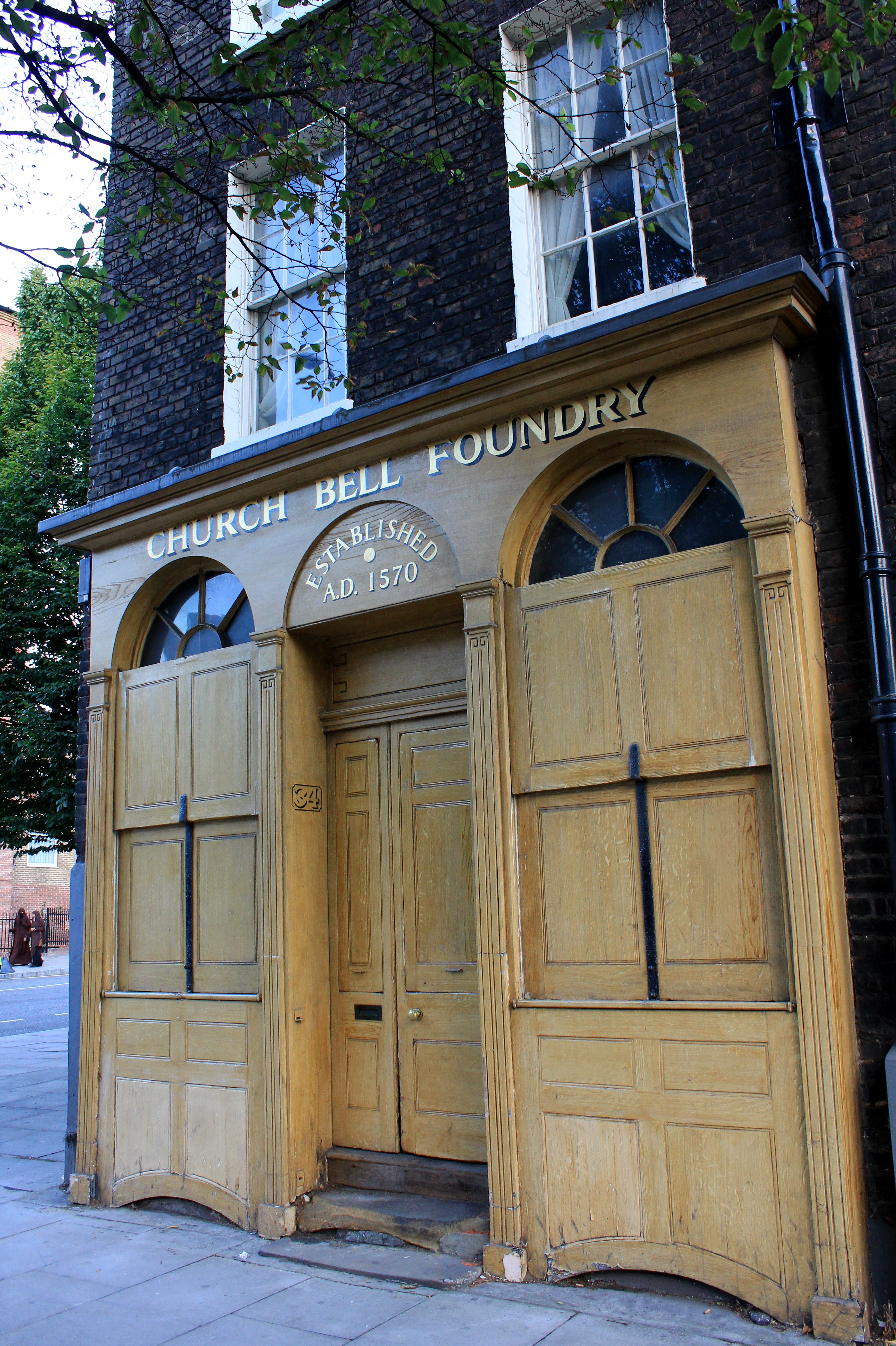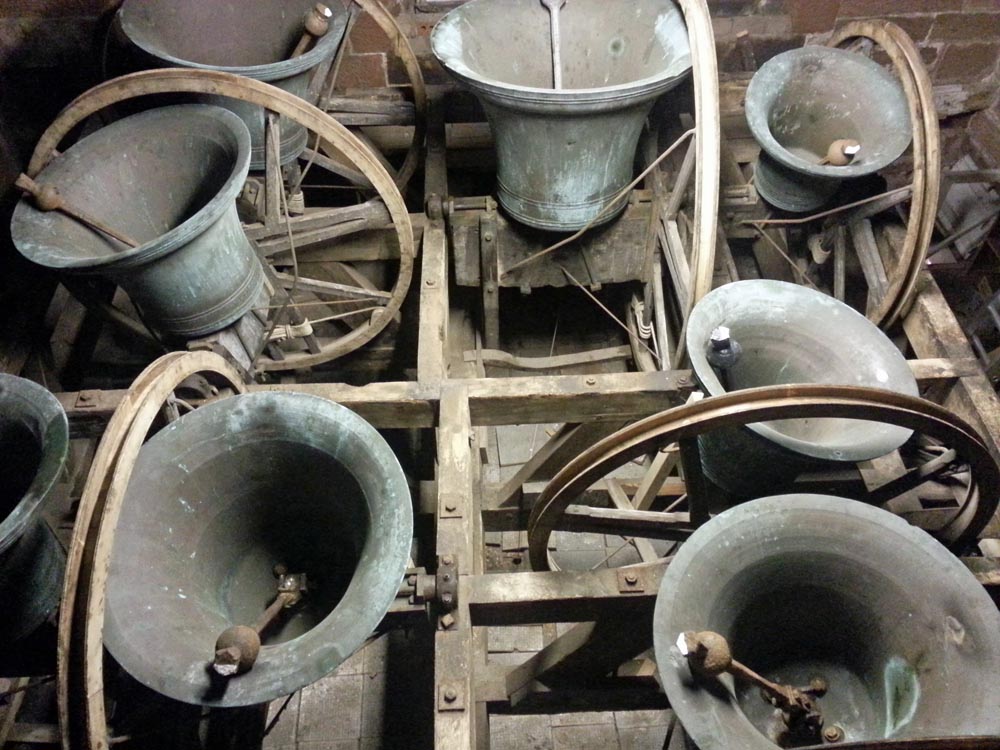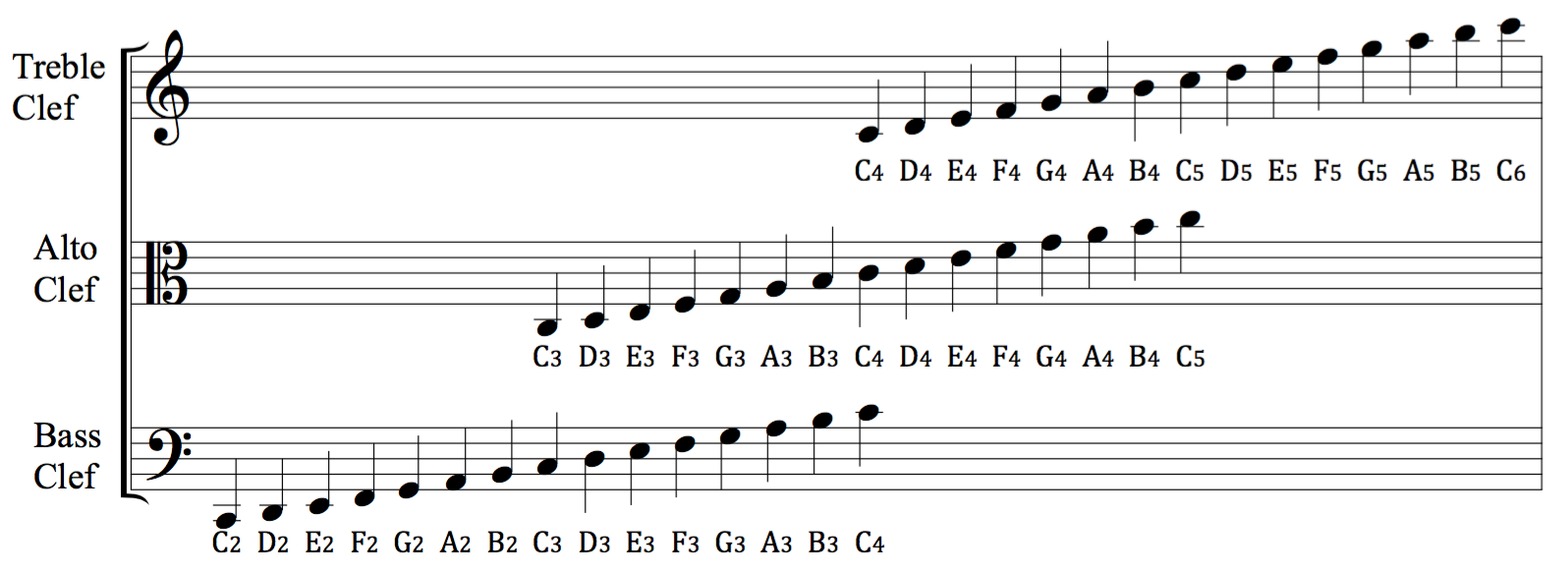|
Handbell
A handbell is a bell designed to be rung by hand. To ring a handbell, a ringer grasps the bell by its slightly flexible handle – traditionally made of leather, but often now made of plastic – and moves the arm to make the hinged clapper strike the inside of the bell. An individual handbell can be used simply as a signal to catch people's attention or summon them together, but handbells are also often heard in tuned sets. History Handheld bells have a long history. Credit for the development of the modern hand bell, or "handbell", is accorded to brothers Robert and William Cor in Aldbourne, Wiltshire, England, between 1696 and 1724. The Cor brothers originally made latten bells for hame boxes, but for reasons unknown they began tuning their bells more finely to have an accurate fundamental tone and fitted them with hinged clappers that moved only in one plane. A foundry in Loughborough, Leicestershire, that originated in the 14th century became John Taylor & Co in 1 ... [...More Info...] [...Related Items...] OR: [Wikipedia] [Google] [Baidu] |
Handchime
Handchimes are musical instruments which are rung by hand, similar to handbells. Typically, they are tuned square tubes with an external clapper mechanism. Many handbell techniques can also be applied to handchimes, though some are more difficult (such as six-in-hand) or impossible (malleting). On a music score, handchimes are indicated by a diamond shape on each note as opposed to an oval shape. Uses Handchimes were originally intended to be used as a training tool for prospective handbell ringers. They are cheaper, easier, lighter and more resilient than handbells, making them more accessible for school groups, church youth choirs and senior citizens' groups.''Using Handchimes'', p. 3 Handchimes are also frequently rung in conjunction with handbells. Certain handbell pieces will involve playing handbells and handchimes at the same time, or alternating between the two through various sections of the music. Handbell ensembles will frequently have a collection of handchimes to u ... [...More Info...] [...Related Items...] OR: [Wikipedia] [Google] [Baidu] |
Whitechapel Bell Foundry
The Whitechapel Bell Foundry was a business in the London Borough of Tower Hamlets. At the time of the closure of its Whitechapel premises, it was the oldest manufacturing company in Great Britain. The bell foundry primarily made church bells and their fittings and accessories, although it also provided single tolling bells, carillon bells and handbells. The foundry was notable for being the original manufacturer of the Liberty Bell, a famous symbol of American independence, and for re-casting Big Ben, which rings from the north clock tower (the Elizabeth Tower) at the Houses of Parliament in London. The Whitechapel premises are a Grade II* listed building. The foundry closed on 12 June 2017, after nearly 450 years of bell-making and 250 years at its Whitechapel site, with the final bell cast given to the Museum of London along with other artefacts used in the manufacturing process, and the building has been sold. Following the sale of the Whitechapel Bell Foundry, the ... [...More Info...] [...Related Items...] OR: [Wikipedia] [Google] [Baidu] |
Bell
A bell /ˈbɛl/ () is a directly struck idiophone percussion instrument. Most bells have the shape of a hollow cup that when struck vibrates in a single strong strike tone, with its sides forming an efficient resonator. The strike may be made by an internal "clapper" or "uvula", an external hammer, or—in small bells—by a small loose sphere enclosed within the body of the bell ( jingle bell). Bells are usually cast from bell metal (a type of bronze) for its resonant properties, but can also be made from other hard materials. This depends on the function. Some small bells such as ornamental bells or cowbells can be made from cast or pressed metal, glass or ceramic, but large bells such as a church, clock and tower bells are normally cast from bell metal. Bells intended to be heard over a wide area can range from a single bell hung in a turret or bell-gable, to a musical ensemble such as an English ring of bells, a carillon or a Russian zvon which are tuned to a common ... [...More Info...] [...Related Items...] OR: [Wikipedia] [Google] [Baidu] |
Change Ringing
Change ringing is the art of ringing a set of tuning (music), tuned bell (instrument), bells in a tightly controlled manner to produce precise variations in their successive striking sequences, known as "changes". This can be by method ringing in which the ringers commit to memory the rules for generating each change, or by call changes, where the ringers are instructed how to generate each change by instructions from a conductor. This creates a form of bell music which cannot be discerned as a conventional melody, but is a series of mathematical sequences. It can also be automated by machinery. Change ringing originated following the invention of English full circle ringing, full-circle tower bell ringing in the early 17th century, when bell ringers found that swinging a bell through a much larger arc than that required for swing-chiming gave control over the time between successive strikes of the clapper. Ordinarily a bell will swing through a small arc only at a set speed govern ... [...More Info...] [...Related Items...] OR: [Wikipedia] [Google] [Baidu] |
Peal
In campanology (bell ringing), a peal is the special name given to a specific type of performance of change ringing which meets certain exacting conditions for duration, complexity and quality. The definition of a peal has changed considerably over the years and its standardisation was one of the motivating factors in the formation of the Central Council of Church Bell Ringers in 1891.Sir Arthur Percival Heywood and the Central Council of Church Bell Ringers by Chris Mew, CC President. The Ringing World 22 April 2016 Currently, for a performance to be recognised as a peal by the Central Council it must consist of sufficient numerical sequences, or "changes" (at least 5,040 changes on up to seven working bells or 5,000 changes on higher numbers), meet a number of other criteria (collectively referred to as the ''decisions''), and be published in ''The Ringing World''. On typical tower bells a peal takes around three hours to ring; the time depends on several factors including t ... [...More Info...] [...Related Items...] OR: [Wikipedia] [Google] [Baidu] |
The Lorenz Corporation
The Lorenz Corporation, previously known as Lorenz Publishing Company, is a music publisher located in Dayton, Ohio, United States. It is best known for its publication of church music Church music is a genre of Christian music written for performance in church, or any musical setting of ecclesiastical liturgy, or music set to words expressing propositions of a sacred nature, such as a hymn. History Early Christian musi ... for smaller congregations served by amateur musicians. It also publishes other varieties of music and general education materials. History The company was founded by E.S. Lorenz in 1890 and has been under the management of E.S. Lorenz and his descendants since that time. The idea came in 1889 "when he had compiled a hymnal for the United Brethren Publishing House located in downtown Dayton." In the 1970s and 1980s, the company changed its name to Lorenz Industries, and then The Lorenz Corporation. Reiff Lorenz, a great great grandson of the founder ... [...More Info...] [...Related Items...] OR: [Wikipedia] [Google] [Baidu] |
Bell
A bell /ˈbɛl/ () is a directly struck idiophone percussion instrument. Most bells have the shape of a hollow cup that when struck vibrates in a single strong strike tone, with its sides forming an efficient resonator. The strike may be made by an internal "clapper" or "uvula", an external hammer, or—in small bells—by a small loose sphere enclosed within the body of the bell ( jingle bell). Bells are usually cast from bell metal (a type of bronze) for its resonant properties, but can also be made from other hard materials. This depends on the function. Some small bells such as ornamental bells or cowbells can be made from cast or pressed metal, glass or ceramic, but large bells such as a church, clock and tower bells are normally cast from bell metal. Bells intended to be heard over a wide area can range from a single bell hung in a turret or bell-gable, to a musical ensemble such as an English ring of bells, a carillon or a Russian zvon which are tuned to a common ... [...More Info...] [...Related Items...] OR: [Wikipedia] [Google] [Baidu] |
Middle C
C or Do is the first note of the C major scale, the third note of the A minor scale (the relative minor of C major), and the fourth note (G, A, B, C) of the Guidonian hand, commonly pitched around 261.63 Hz. The actual frequency has depended on historical pitch standards, and for transposing instruments a distinction is made between written and sounding or concert pitch. It has enharmonic equivalents of B and D. In English the term ''Do'' is used interchangeably with C only in the context of fixed Do solfège; in the movable Do system Do refers to the tonic of the prevailing key. Frequency Historically, concert pitch has varied. For an instrument in equal temperament tuned to the A440 pitch standard widely adopted in 1939, middle C has a frequency around 261.63 Hz (for other notes see piano key frequencies). Scientific pitch was originally proposed in 1713 by French physicist Joseph Sauveur and based on the numerically convenient frequency of 256 ... [...More Info...] [...Related Items...] OR: [Wikipedia] [Google] [Baidu] |
Alfred Music
Alfred Music is an American music publishing company. Founded in New York in 1922, it is headquartered in Van Nuys, California, with additional branches in Miami, New York, Germany, Singapore, and the United Kingdom. History In New York City’s Tin Pan Alley in 1922, Sam Manus, a violinist and importer of mood music for silent films, started a music publishing company and named it Manus Music. The company published primarily popular sheet music. In 1930, Sam acquired the music publisher, Alfred & Company, founded by Alfred Haase. Sam decided to combine the names and shortened it to Alfred Music, which the company is still known as today. Sam's son, Morty ''(né'' Morton Manus; 1926–2016), clarinetist and pianist, began working for Alfred Music in the late 1940s and met his wife Iris at the company when the bookkeeper, Rose Kopelman, brought her daughter to work one day. Inspired by the need for quality music educational products. Morty, a clarinetist and pianist, oversaw t ... [...More Info...] [...Related Items...] OR: [Wikipedia] [Google] [Baidu] |
Melody
A melody (), also tune, voice, or line, is a linear succession of musical tones that the listener perceives as a single entity. In its most literal sense, a melody is a combination of Pitch (music), pitch and rhythm, while more figuratively, the term can include other musical elements such as Timbre, tonal color. It is the foreground to the background accompaniment. A line or Part (music), part need not be a foreground melody. Melodies often consist of one or more musical Phrase (music), phrases or Motif (music), motifs, and are usually repeated throughout a Musical composition, composition in various forms. Melodies may also be described by their melodic motion or the pitches or the interval (music), intervals between pitches (predominantly steps and skips, conjunct or disjunct or with further restrictions), pitch range, tension (music), tension and release, continuity and coherence, cadence (music), cadence, and shape. Function and elements Johann Philipp Kirnberger arg ... [...More Info...] [...Related Items...] OR: [Wikipedia] [Google] [Baidu] |
Bass Clef
A clef (from French: 'key') is a musical symbol used to indicate which notes are represented by the lines and spaces on a musical staff. Placing a clef on a staff assigns a particular pitch to one of the five lines or four spaces, which defines the pitches on the remaining lines and spaces. The three clef symbols used in modern music notation are the G-clef, F-clef, and C-clef. Placing these clefs on a line fixes a reference note to that line—an F-clef fixes the F below middle C, a C-clef fixes middle C, and a G-clef fixes the G above middle C. In modern music notation, the G-clef is most frequently seen as treble clef (placing G4 on the second line of the staff), and the F-clef as bass clef (placing F3 on the fourth line). The C-clef is mostly encountered as alto clef (placing middle C on the third line) or tenor clef (middle C on the fourth line). A clef may be placed on a space instead of a line, but this is rare. The use of different clefs makes it possible ... [...More Info...] [...Related Items...] OR: [Wikipedia] [Google] [Baidu] |







